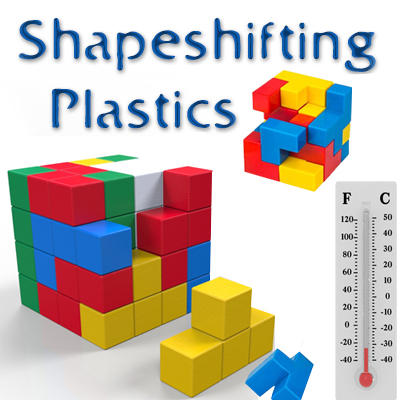Shapeshifting Plastics a revolution in the smart age

In the 'smart age' of the smart phones and smart watches and smart what not, the industry too, needs to pull its socks up.
If you had been waiting for the same, you might just as well be glad to know of shape memory polymers which are “smart” plastic materials that can be converted to any shape, a temporary one, and then again be revamped into its original shape, all because of external stimulus from heat and pressure. These smart polymers can be made into complex shapes like coils, knots, even those origami-like shapes that seem an artistic breathe into boredom!
In recent times, reversible ‘shape memory’ has been enabled in few polymers. But being able to switch between shapes requires a continual external force, more specifically mechanical. Researchers, therefore have now resorted to elastomers, polymers with great elasticity and viscosity, bearing carefully designed chemical structures.
A team of scientists has devised a certain method for arriving at reversible shifting between programmable shapes, thus making them smart. They tried using semi-crystalline elastomers with uniform chemical structures of several kinds and have been able to achieve several shapes without the application of any mechanical force.
A paper that has been put together stating the results of the study titked “Shapelifting: Reversible Shape Memory in Semi-Crystalline Elastomers” that is also available online in a journal Macromolecules
"We're uniquely able to achieve reversible transformations, not just one-way shape changes from one state to another, by taking advantage of interactions between crystalline polymer domains and chemical network of polymers," mentioned Oleg Gang, group leader for Soft and Bio NanoMaterials at the Brookhaven's Center for Functional Nanomaterials.
He went on to explain that ‘shape memory materials' are extremely significant for invasive surgery, hands-free packaging, aerospace industry and also microbiotics. Reversible shape polymers are specifically attractive for these fields because they allow for extremely high complex shape transformations on a broad length scale and respond to a variety of external stimuli – more specifically heat, light, electro-magnetic fields and acoustic waves.
The researchers fabricated the elastomers, twisted them carefully into coil like structures at a temperature of about 140ºF and then cooled suddenly to about 40°F. Once these were re-heated to about 100ºF, the straight elatomers once again took on the coiled shapes spontaneously, without any external force being applied to them. The several angles of the coil were repeatedly reproduced, even after several heating and cooling cycles had been performed. A very similar behavior was depicted in a straight polymer bending to a pre-determined angle and an origami-like star or a gripper folding and then again unfolding on its own.
The scientists involved, used a small angle X-ray scattering (SAXS) at Brookhaven's Center for Functional Nanomaterials and on beamline X9 at the National Synchrotron Light Source in order to determine the nano-scale structural changes in these polymers during shapeshifting and the specific molecular behavior and mechanism that causes such reversibility.
"We are only beginning to understand the molecular, nano- and meso-scale effects in this material. Many structural changes are happening on various scales simultaneously, and it is not fully clear which phenomenon dominates," Gang said. "The complexity of these materials arises from the interplay of a sca?old of small crystallites and a chemically cross-linked polymer network, which makes the study more challenging but also more stimulating. We are excited about new possibilities that NSLS-II will provide, since it will address our currently limited ability to probe structure and dynamics at multiple scales in real time when macroscopic transformations occur or mechanical stress is applied."
[The team of scientists being from University of North Carolina (UNC) at Chapel Hill, University of Connecticut, and U.S. Department of Energy's Brookhaven National Laboratory, led by Sergei Sheiko (UNC)]
Source:phys.org


